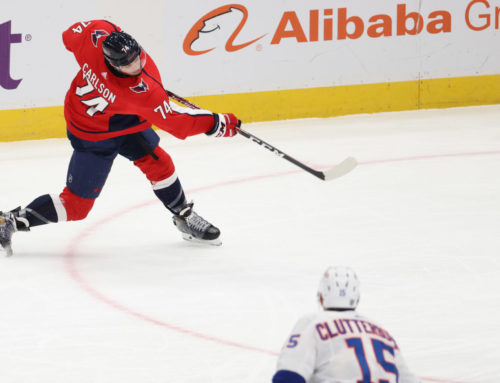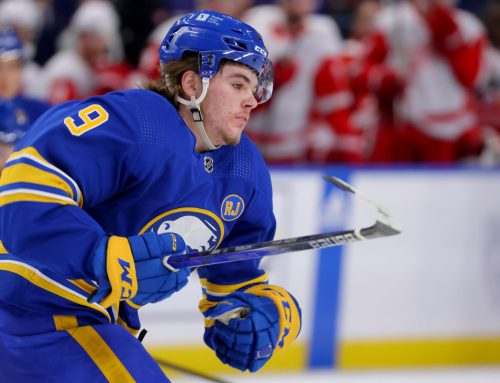
Discussions have been ongoing for most of this week now as to what the Edmonton forward chart will look like this coming season. As discussed in a recent Ramblings, I don’t think there’s much certainty at all beyond locking Connor McDavid in as the top-line centre. Oilers analyst Bob Stauffer took a shot at projecting the lines:
Stauffer projected lines:
Maroon-McDavid-RNH
Lucic-Leon-Slepyshev
Caggiula-Strome-Puljujarvi
Jokinen-Letesu-Kassian
Khaira-Pakarinen— Bob Stauffer (@Bob_Stauffer) July 9, 2017
Not that those are the lines, or anything close to them, but writing it out like that can show just how hard it is to put them together.
It got me thinking about what to do with Patrick Maroon.
Playing alongside McDavid for most of the season, Maroon put up 27 total goals, 24 of them coming at five-on-five. Those 24 goals tied for fifth in the NHL, which is just kind of surreal to think about. Add in nearly 100 penalty minutes and over two shots on goal per game, and he was an exceptional value in fantasy.
Staying alongside McDavid is another question. There are loads of options to use there, and if he gets moved to the third line or something, he has very little fantasy value. So I pose to the Dobber community: in a standard roto league, how high are you drafting Maroon this year?
****
Throughout the off-season, I’ve been going team-by-team to discuss the relevant fantasy performances from the previous year. Next in the list alphabetically is Nashville.
There are always a few players that fantasy owners panic over at the start of the season due to a slow start. Anecdotally, the player I received more DMs, emails, and texts over was Forsberg, and with good reason – no goals in 13 games, one goal in 18 games, and two goals in 27 games to start the year is enough to make even the most seasoned fantasy vet panic. He went on an absolute tear after Christmas, however, and finished with 31 goals on the season.
Reasons why Forsberg didn’t have the true breakout season some (including myself) were hoping for is quite simple: the Nashville power play and his contributions to it. On a goals-per-minute rate, the Predators were only marginally better than Carolina with the man advantage, and outside the top-10 in total goals scored. That they weren’t overly prolific was part one.
Part two is that he managed a point on fewer than 40 percent of power-play goals scored with him on the ice. Over his first two full seasons, that number was nearly 72 percent. That first number is actually 39.1 percent, the second-lowest mark of any forward in the NHL this year with at least 200 minutes of power-play time, and just one of two players under 40 percent (Derick Brassard was the other).
It’s no secret the Nashville power play runs through the defencemen, but a rebound in the power-play points is coming. He’s a focal point of the offence, and these types of outliers tend to rebound (unless you’re Sam Reinhart). It is easily foreseeable that he pushes closer to 20 power-play points rather than fails to crack 10 next year.
Assuming those power-play points come through, there is a lot of upside here (top-10 forward upside in roto leagues). As it is, he compares favourably to someone like Max Pacioretty, and has the ability to put up seasons like we’ve seen in recent years from Joe Pavelski. He should be a bit cheaper at the draft table this year, but I am still drafting him inside the top-50.
Johansen has undergone a change in personal style of sorts since coming over from Columbus. In his two big offensive season with the Jackets, he averaged over 2.6 shots per game, while that number has dipped to nearly an even 2.0 since donning a Predators uniform. His mark of 1.88 shots per game in 2016-17 was the lowest since his rookie season.
One can hardly blame him, though, given his three most-common wingers were Forsberg, Viktor Arvidsson, and James Neal, all shooters. He doesn’t need to take the shots, he needs to put himself in a situation where he can find his wingers in shooting positions. That’s his job.
Being the distributor does have its upsides, of course – the soon-to-be 25-year-old centre managed a career high with 47 assists, and tied a career-best with 19 power-play assists. All these assists helped him become one of just 12 forwards with four consecutive 60-point seasons since the lockout year, and the list is prolific (via Hockey Reference):
.png)
Settling into his role has allowed Johansen to fulfill a need for the Predators, but it also creates problems for fantasy owners. The long and short of it is his fantasy value varies wildly across different league setups. In a points-only league, he could be very useful depending how goals and assists are valued. In standard roto leagues, however, the lack of peripherals meant that despite 61 points, 23 of which came with the man advantage, he still wasn’t a top-50 option. Even if he adds a handful of goals, he’s barely a top-50 player in such leagues, and that is where he will probably be overvalued.
Being a fringe top-50 roto option is still very, very good, I don’t want to give the impression that he’s useless or something. However, the lack of shots and goals means that being roughly a top-50 player is about his ceiling. Whereas you can draft Forsberg inside the top-50 and legitimately hope for a top-10 season, if you draft Johansen inside the top-50, you’re hoping he simply returns that value.
Including Smith here might be a bit odd, but it’s more because he really caught my eye in the postseason once he was dressed for the Pittsburgh series. He sure played like he had something to prove in the limited minutes he was given.
More than a handful of playoff games, though, is the fact that he was a pretty consistent producer in the three years post-lockout. Below is the list of players with at least 60 goals, 60 assists, 660 shots on goal, and 99 penalty minutes from 2013 through 2016 (or averaging 20-20-220-33):
He never really excelled, but was solid enough to warrant late-round draft picks in 12-team leagues that could fill in for injuries. That obviously fell off a cliff this year as he was given fewer than 14 minutes a game for the first time since the lockout year (or fewer than 15 minutes for that matter), and he produced just 29 points.
The percentage at which he accumulated points when he was on the ice at five-on-five (61.9 percent) wasn’t too dissimilar from 2013-16 at 64.4 percent. He also had a very similar rate of shot attempts (17.53 per 60 minutes) from the three previous years as well (17.39 per 60 minutes). When he was on the ice, then, he was pretty much the player he’d been for years. The coaching staff pushed him down the depth chart, and playing with less-talented players meant a big ding in his on-ice goals for, which showed in his points-per-minute rate.
A player who was more or less the same guy he’d always been was pushed down the depth chart, and given their options at right wing last year, there was good reason. However, with James Neal gone, and no immediate replacement, he should find himself back on the second line behind the duo of Forsberg/Arvidsson.
That is the big takeaway here. Yes, last season was bad for him production-wise. But there should be an opportunity for him to earn more ice time, and there’s no obvious indication that his on-ice skills have diminished. He’ll never be a 60-point guy, but he can probably be a useful depth piece in fantasy leagues again.
All told, it was a fine offensive season for Subban. Injuries limited him to just 66 games, but 10 goals and 40 points in those 66 games is passable. Had he played a full season, he probably pushes 50 points, which is closer to what fantasy players were hoping for.
Immediately, what is glaring is the power-play usage. In the 2015-16 season with the Habs, Subban averaged 4:33 per game in power-play minutes. That number dropped by over two full minutes to 2:30 per game this past year with Nashville as the ice time was more or less distributed among three defencemen. Even though his points per 60 minutes at five-on-five (1.03) were similar to that in Montreal (1.1), and the points per 60 minutes on the power play (5.61) considerably higher than his final three years with the Canadiens (4.07), the volume of minutes just wasn’t there.
This should force people to think about their defensive rankings for 2017-18. It’s not to say he won’t be a big fantasy contributor, but he’ll probably be ranked inside, or very close to, the top-5 blue liners in all formats. The consensus seems to be Erik Karlsson, Brent Burns, and Victor Hedman, with Subban in the mix with three or four different rearguards after that. But if he’s not logging heavy power-play minutes, and his ice time remains constant (and, barring injury, I would think it does – with that defence corps, there’s no need for one player to log 26-27 minutes a game), how much upside is there? I do think he can be a 50-point guy in a full year, but drafting him with any expectation that he gets back to the 60-point plateau would be a mistake.
2 Comments
Leave A Comment
You must be logged in to post a comment.





 TOR
TOR EDM
EDM ANA
ANA PIT
PIT BUF
BUF S.J
S.J MIN
MIN DET
DET CBJ
CBJ UTA
UTA MTL
MTL

My initial line up Has Strome as a RW. I don’t see Strome playing C in Edm anytime soon, he isn’t a very good C but has solid potential as a RW. Waivers will also be a factor. Most teams carry a standard contingent of 13F, 8D & 2 G’s. Injury’s can cause slight adjustments to the point some teams ofetn even dress 7 Dman in a game playing 1 as a forward but teams generally dress 12F, 6D & 2G’s for games.
Only Slepyshev, Puljujarvi & McDavid aren’t required to clear waivers. McDavid isn’t getting sent down, so 1 of the other 2 will need to be sent down or Khaira or Pakarinen waived for both of them to stay. Unless injuries dictate otherwise. With Sekera injured to start the season Edm could choose to carry 14F, 7D & 2G’s. Injures happen so a roster spot would open up soon enough.
For now listing 14 forwards is fine but come the day before the season starts players could be moved to the minors to address the 23 man roster requirement, then placed on LTIR or other & players recalled. Regardless I don’t see Strome brought into play C, he will play RW. An area that EDM needs help at unless Draisaitl plays RW.
Maroon-McDavid-Strome
Lucic-Leon-Puljujarvi
Jokinen-RNH-Kassian
Caggiula-Letesu-Slepyshev
Khaira-Pakarinen
I think your lines make a lot of sense here, they can use that RNH line as a shutdown line and let the other two get some softer matchups. Would do wonders for Strome, too.